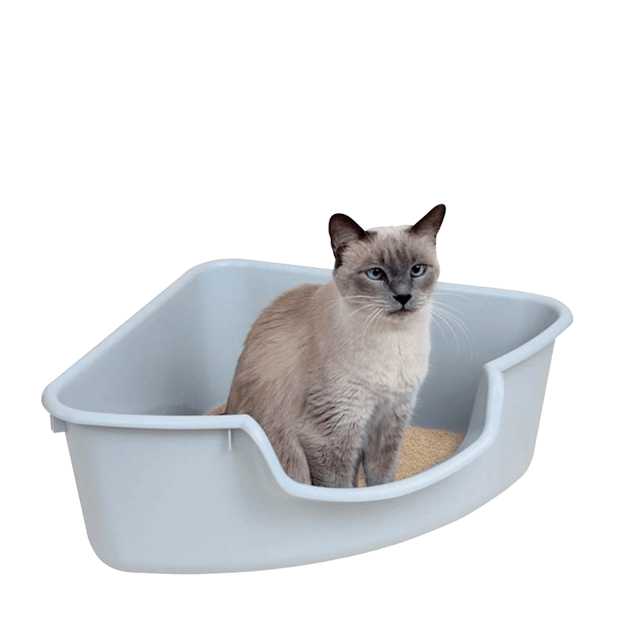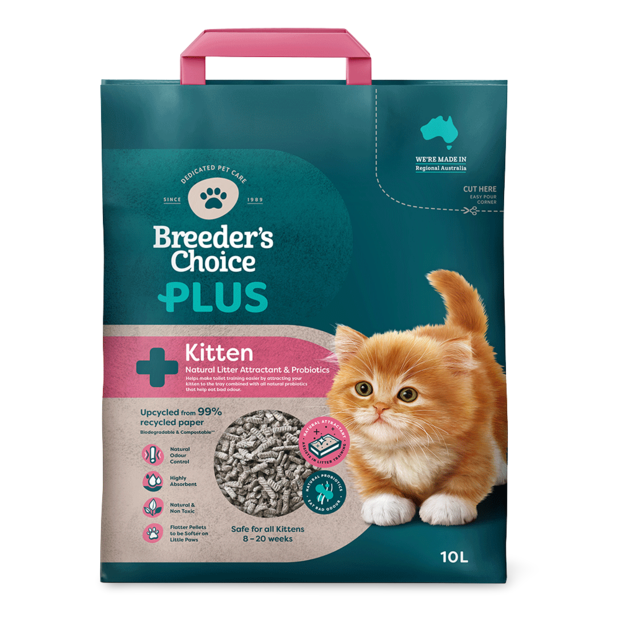How To Toilet Train Your New Kitten
This article is written by Pet Circle veterinarian, and last updated by .
Congratulations on your new, furry, purry bundle of joy! Now that your kitten is settling into their new home, one of your first priorities is likely to be litter box training.
Do kittens need to be toilet trained? It is important that your kitten learns where they should go to toilet. Cultivating appropriate toileting behaviour helps to maintain good hygiene within your house.
Fortunately, cats value cleanliness and instinctively want to bury their waste. Indoor cats usually take to using a litter box naturally, so long as it is accessible and clean. This means that toilet training your kitten is usually fairly easy and straightforward!
Skip to a Section
Controlling your kitten's space
Reinforcing positive behaviour
Maintaining a clean environment
Choose the Right Litter Tray
Select a suitable litter tray
The litter tray/box and type of kitty litter that you choose will come down to personal preference. If your kitten was already using litter when they were in their previous home, try and use the same type of litter and litter tray to start with. This will increase your chances of success.
The litter tray should be simple and convenient when starting out. Make sure that the sides or entrance are low enough for your little kitten to get over with ease.
Ensure the tray is large enough
Cats prefer a litter tray with plenty of space for them to move around. The ideal size would be 1.5 times the length of your cat (measure from the nose to the base of their tail).
Avoid covered, door-equipped, or self-cleaning litter trays
It's easiest to begin toilet training with a basic uncovered litter tray. Your kitten will first need to understand how to use litter for toileting and where to go. Their toilet should be obvious, and litter trays with easy access will encourage your kitten to use it and have less accidents. You may progress to covered or door-equipped litter boxes after they have mastered the basics.
Self-cleaning trays are most suitable for adult, well-trained cats. These trays may require a specific litter substrate which could be a clumping type or crystals, and neither of these are ideal for small kittens. The automatic cleaning system may also alarm and deter some cats from using the litter tray. This could affect the success of your kitten's toilet training.
Consider upsizing as the kitten grows
As your kitten grows, so should the size of the litter box. Make sure your litter tray can still provide ample space for your cat to turn around and scratch about in the litter.
Selecting the Best Litter
Choose the right cat litter type
First and foremost, pick the type of litter best suited to your cat's individual preferences!
If you are introducing your kitten to toilet training, it is recommended to use a natural based, non-clumping type of litter for kittens such as paper and wood litter. Clumping litters and silica crystal types are best avoided as they could cause intestinal blockages when ingested. It is not unusual for small kittens to be curious and attempt to eat their litter substrate.
Find the best litter for your cat with our complete guide to cat litter.
Best litter for kittens
Consult the breeder or shelter
As mentioned earlier, it's best to stick to the same litter the breeder, shelter or previous owner of your kitten had been using. Providing this constant can help to reduce accidents.
Finding the Optimal Location
Place the litter tray in a quiet area
Make sure you place the litter boxes in various locations so they have plenty of choices. Each location should offer your kitten some privacy, and is away from dogs, children and noisy appliances. Loud noises and high movement areas can deter your cat from using their toilet.
Provide privacy
Nobody likes being disturbed while toileting, including your kitten. Strategically placing the litter tray in a low-traffic area can help create some privacy. Hooded litter boxes and doors can offer extra seclusion for shy kitties.
Keep away from food and water
Cats do not like to toilet near their food and water bowls. Ensure that these are kept separate from their litter tray.
Controlling Your Kitten's Space
Allocate a small area for your kitten
To begin with, try to limit your kitten's access to just a few rooms of the house. This allows you to monitor their activity and means the litter box is always within easy reach. Read our guide to introducing a new cat to your household if you already have cats.
Keep the litter tray close
Kittens have less control over their urination and placing the litter tray in an easily accessible place, not too far away, will help minimise accidents. The more your kitten uses their litter tray, the faster they will learn.

Reinforcing Positive Behaviour
Place your kitten in the litter tray
Gently place your kitten in the litter box at an opportune time, such as after playing, waking up from a nap, or finishing a meal. If your kitten has an accident, you may also place some of their faeces in the litterbox for a while to give them the right idea.
Use gentle encouragement
Give them plenty of praise or pats, immediately after they have toileted correctly to encourage your kitten to continue using the litter tray.
Dealing with Accidents
There will be accidents from time to time. This is normal as your kitten is still learning!
Avoid punishment for accidents
It is very important that you don't punish your kitten if they have an accident. Rubbing their nose in the evidence or shouting at them will only make them fearful and less likely to do what you want them to.
If you catch your kitten in the act, quietly pick them up and place them in the litter box.
Clean accidents immediately
Make sure you clean any mishaps up with an enzymatic cleaner or cat odour spray, otherwise the smell left behind could encourage him to toilet in the same place again.
Encourage the kitten to use the litter tray
Kittens generally learn to use litter trays quickly over several weeks. To provide your kitten with some extra help, you could use the Breeders Choice Kitten Litter to assist with training. This litter is infused with an attractant, which is naturally appealing to cats to help them learn where to go to the toilet. Its probiotic component also helps with odour control.
Maintaining a Clean Environment
Regular checking and cleaning the litter tray
Your cat will be much more likely to return to the litter tray if it is nice and clean, so it's best to check the litter tray regularly. Once your kitten has used the litter box, make sure to clean up the mess promptly.
Thoroughly wash the litter tray weekly
Use a litter scoop to remove solid waste on a daily basis and change the litter completely every week or two. Have a look at the back of the litter packet; most will have a guide as to how often it should be replaced.
Use a pet-friendly cleaning product
The best cleaners to use are the enzymatic cleaners which can break down the urine and thoroughly eliminate stains and odours. Avoid disinfectants containing bleach, ammonia or strong fragrances. These are unsafe for use around cats and strong smells may discourage use of the litter tray.
Conclusion
Remember to be patient with your new kitten. It will take a little trial and error but by providing him with lots of encouragement, a clean and inviting litter box, your kitten will be using it like a pro in no time!
Need supplies for a new kitten?
Check out our Better Kitten Bundle - a complete vet-approved kitten essentials pack, designed to help tick off your 'new kitten checklist'. It contains parasite prevention, toys, a scratcher, treats, litter, food vouchers, and more!
Filled with over $185 worth of products, our discounted price ($49.95) makes for incredible value. You couldn't ask for a more 'purrfect' welcome pack for a new kitten!
Further Reading
10 Must-Have Cat Products for Home Alone Cats
Choose the Perfect Cat Furniture
Want to know more? Check out our Discover Page for more tips from our expert Vets on keeping your kitten happy and healthy.





























